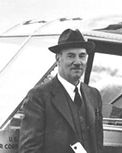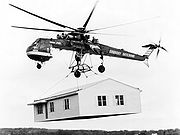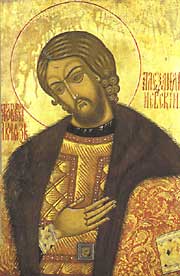Igor Sikorsky
| Igor Sikorsky | |
|---|---|
 |
|
| Born | May 25, 1889 Kiev, Russian Empire (today Ukraine) |
| Died | October 26, 1972 (aged 83) Easton, Connecticut, USA, buried Saint John the Baptist Greek Catholic Cemetery, Stratford, Connecticut |
| Nationality | Russian-American |
| Ethnicity | Polish, Russian, Ukrainian |
| Alma mater | Imperial Russian Naval Academy Kiev Polytechnic Institute ETACA |
| Occupation | Aircraft designer |
| Known for | First successful helicopter |
| Religion | Russian Orthodox |
| Spouse | Olga Fyodorovna Simkovitch Elisabeth Semion |
| Children | Tania, Sergei, Nikolai, Igor, George |
| Awards | Order of St. Vladimir National Medal of Science Wright Brothers Memorial Trophy Howard N. Potts Medal (1933) |
Igor Sikorsky (May 25, 1889 – October 26, 1972),[1] born Igor Ivanovich Sikorsky (Russian: Игорь Иванович Сикорский, Ukrainian: Ігор Іванович Сікорський), was a Russian-American pioneer of aviation in both helicopters and fixed-wing aircraft. He designed and flew the world's first multi-engine fixed-wing aircraft, the Russky Vityaz in 1913, and the first airliner, Ilya Muromets, in 1914. After immigrating to the United States in 1919, Sikorsky founded the Sikorsky Aircraft Corporation in 1923,[2] and developed the first of Pan American Airways' ocean-conquering flying boats in the 1930s. In 1939, he designed and flew the Vought-Sikorsky VS-300,[3] the first viable American helicopter, which pioneered the rotor configuration used by most helicopters today.[4] Sikorsky would modify the design into the Sikorsky R-4, which became the world's first mass-produced helicopter in 1942.
Contents |
Biography
Early life
Igor Sikorsky was born in Kiev, Russian Empire (present day Ukraine), as the youngest of five children. His father, Ivan Alexeevich Sikorsky, had a Russian and noble Polish (Polish: szlachta) family background. A professor of psychology, Ivan was the son and grandson of Russian Orthodox priests and held monarchist and Russian nationalist views.[5][6][7][8][9]
Igor Sikorsky's mother, Mariya Stefanovna Sikorskaya (née Temryuk-Cherkasova), [10] was a physician who did not work professionally. While homeschooling young Igor, she gave him a great love for art, especially in the life and work of Leonardo da Vinci, and the stories of Jules Verne. In 1900, at age 11, he accompanied his father to Germany and through conversations with his father, became interested in natural sciences. After returning home, Sikorsky began to experiment with model flying machines, and by age 12, he had made a small rubber band-powered helicopter.[11]
Sikorsky began studying at the Saint Petersburg Imperial Russian Naval Academy, in 1903, at the age of 14. In 1906, he determined that his future lay in engineering, so he resigned from the Academy, despite his satisfactory standing, and left the Russian Empire to study in Paris. He returned to Russia in 1907, enrolling at the Mechanical College of the Kiev Polytechnic Institute. After the academic year, Sikorsky again accompanied his father to Germany in the summer of 1908, where he learned of the accomplishments of the Wright Brothers' Flyer and Count von Zeppelin's dirigible.[12] Sikorsky later said about this event: "Within twenty-four hours, I decided to change my life's work. I would study aviation."[13]
Aircraft designer

.jpg)
With financial backing from his sister Olga, Sikorsky returned to Paris in 1909 to study aeronautics in the world-renowned Ecole des Techniques Aéronautiques et de Construction Automobile (ETACA) engineering school and to purchase aircraft parts. At the time, Paris was the center of the aviation world. Sikorsky would meet with aviation pioneers, to ask them questions about aircraft and flying. In May 1909, he returned to Russia and began designing his first helicopter, which he began testing in July 1909. Despite his progress in solving technical problems of control, Sikorsky realized that the aircraft would never fly. He finally disassembled the aircraft in October 1909, after he determined that he could learn nothing more from the design.[14]
| “ | I had learned enough to recognize that with the existing state of the art, engines, materials, and— most of all— the shortage of money and lack of experience... I would not be able to produce a successful helicopter at that time.[15] | ” |
Sikorsky built the two-seat S-5, his first design not based on other European aircraft. Flying this original aircraft, Sikorsky earned his pilot license; Fédération Aéronautique Internationale (FAI) license No. 64 issued by the Imperial Aero Club of Russia in 1911.[16] During a demonstration of the S-5, the engine quit and Sikorsky was forced to make a crash landing to avoid a wall. It was discovered that a mosquito had flown into the gasoline and had been drawn into the carburetor, starving the engine of fuel. The close call convinced Sikorsky of the need for an aircraft that could continue flying if it lost an engine.[17] His next aircraft, the S-6 held three passengers and was selected as the winner of the Moscow aircraft exhibition held by the Russian Army in February 1912.[16]
In early 1912, Igor Sikorsky became Chief Engineer of the aircraft division for the Russian Baltic Railroad Car Works (Russko-Baltiisky Vagonny Zavod or R-BVZ)[18] in Saint Petersburg.[19] His work at R-BVZ included the construction the first four-engine airplane, the S-21 Russky Vityaz, which he called Le Grand. He also served as the test pilot for its first flight on 13 May 1913. In recognition for his accomplishment, he was awarded an honorary degree in engineering from Saint Petersburg Polytechnical Institute in 1914. Sikorsky took the experience from building the Russky Vityaz to develop the S-22 Ilya Muromets airliner. Due to outbreak of world War I, he redesigned as the world's first four-engined bomber, for which he was decorated with the Order of St. Vladimir.
After World War I, Igor Sikorsky briefly became an engineer for the French forces in Russia, during the Russian Civil War.[20] Seeing little opportunity for himself as an aircraft designer in war-torn Europe, and particularly Russia, ravaged by the October Revolution and Civil War, he emigrated to the United States, arriving in New York on March 30, 1919.[21][22]
Life in America

.jpg)

In the United States, Sikorsky first worked as a school teacher and a lecturer, while looking for an opportunity to work in the aviation industry. In 1932, he joined the faculty of the University of Rhode Island to form an Aeronautical Engineering program and remained with the University until 1948.[23] He also lectured at the University of Bridgeport.
In 1923, Sikorsky formed the Sikorsky Manufacturing Company in Roosevelt, New York.[24] He was helped by several former Russian military officers. Among Sikorsky's chief supporters was composer Sergei Rachmaninoff, who introduced himself by writing a check for US$5,000 (approximately $61,000 in 2007 dollars).[25] Although his prototype was damaged in its first test flight, Sikorsky persuaded his reluctant backers to invest another $2,500. With the additional funds, he produced the S-29, one of the first twin-engine aircraft in America, with a capacity for 14 passengers and a speed of 115 mph.[26] The performance of the S-29, slow compared to military aircraft of 1918, proved to be a "make or break" moment for Sikorsky's funding.
In 1928, Sikorsky became a naturalized citizen of the United States. The Sikorsky Manufacturing Company moved to Stratford, Connecticut in 1929. It became a part of United Aircraft and Transport (now United Technologies Corporation) in July of that year.[27] The company manufactured flying boats, such as the S-42 "Clipper", used by Pan Am for trans-Atlantic flights.[15]
Meanwhile, Sikorsky also continued his earlier work on vertical flight. On February 14, 1929, he filed an application to patent a "direct lift" amphibian aircraft which used compressed air to power a direct lift "propeller" and two smaller propellers for thrust.[28] On June 27, 1931, Sikorsky filed for a patent for another "direct lift aircraft", and was awarded patent #1,994,488 on 19 March 1935.[29] His design plans eventually culminated in the first (tethered) flight of the Vought-Sikorsky VS-300 on September 14, 1939, with the first free flight occurring eight months later on May 26, 1940. Sikorsky's success with the VS-300 led to the R-4, which became the world's first mass produced helicopter in 1942. Sikorsky's final VS-300 rotor configuration, comprising a single main rotor and a single antitorque tail rotor, has proven to be one of the most popular helicopter configurations, being used in most helicopters produced today.[30]
Marriage and children
Sikorsky was married to Olga Fyodorovna Simkovitch in Russia. They were divorced and Olga remained in Russia with their daughter as Sikorsky departed ahead of the October Revolution. In 1923, Sikorsky's sisters emigrated to the United States, bringing six-year old Tania with them.[31] Sikorsky married Elisabeth Semion in 1924, in New York.[32] Sikorsky and Elisabeth had four sons; Sergei, Nikolai, Igor Jr., and George.
- Tania Sikorsky von York (1918 – September 22, 2008) Sikorsky's eldest child and only daughter. Tania was born in Kiev, Ukrainian People's Republic, a short lived republic during the early rise of Russian Bolsheviks, eventually part of the USSR. Educated in the United States, she earned a B.A. at Barnard College and a doctorate at Yale. She was one of the original faculty members of Sacred Heart University in Bridgeport, Connecticut, where she served as Professor of Sociology for 20 years.[33]
- Sergei Sikorsky (1925 – ) Sikorsky's eldest son, Sergei served in the United States Coast Guard and earned a degree from the University of Florence. He joined United Technologies in 1951, and retired in 1992, as Vice-President of Special Projects at Sikorsky Aircraft.[34][35]
Death and legacy
Sikorsky died at his home in Easton, Connecticut, on October 26, 1972, and was buried in Saint John the Baptist Greek Catholic Cemetery in Stratford. The Sikorsky Memorial Bridge, which carries the Merritt Parkway across the Housatonic River next to the Sikorsky corporate headquarters, is named for him. Sikorsky has been designated a Connecticut Aviation Pioneer by the Connecticut State Legislature. The Sikorsky Aircraft Corporation in Stratford, Connecticut, continues to the present day as one of the world's leading helicopter manufacturers, and a nearby small airport has been named Sikorsky Memorial Airport.[36]
Sikorsky was inducted into the National Inventors Hall of Fame and the Junior Achievement U.S. Business Hall of Fame in 1987.[37][38]
Philosophical and religious views
Sikorsky was a deeply religious Russian Orthodox Christian and authored two religious and philosophical books (The Message of the Lord's Prayer and The Invisible Encounter). Summarizing his beliefs, in the latter he wrote:
| “ | Our concerns sink into insignificance when compared with the eternal value of human personality - a potential child of God which is destined to triumph over lie, pain, and death. No one can take this sublime meaning of life away from us, and this is the one thing that matters.[39] | ” |
Published works
- Sikorsky, Igor Ivan. The Message of the Lord's Prayer. New York: C. Scribner's sons, 1942. OCLC 2928920
- Sikorsky, Igor Ivan. The Invisible Encounter. New York: C. Scribner's Sons, 1947. OCLC 1446225
- Sikorsky, Igor Ivan. The Story of the Winged-S: Late Developments and Recent Photographs of the Helicopter, an Autobiography. New York: Dodd, Mead, 1967. OCLC 1396277
See also
- Aerosan—Sikorsky built some of these propeller-powered sleighs in 1909–10.
- Il'ya Muromets - Second four-engine aircraft designed by Igor Sikorsky
- Sikorsky Prize - A prize for human powered helicopters named in his honor.
- 10090 Sikorsky, an asteroid named in honor of Igor Sikorsky
- Timeline of hydrogen technologies
References
- Notes
- ↑ Fortier, Rénald. "Igor Sikorsky: One Man, Three Careers." aviation.technomuses.ca,1996. Retrieved: October 29, 2008.
- ↑ "About Sikorsky." Sikorsky Aircraft. Retrieved: December 11, 2008.
- ↑ Spenser 1998, p. 25.
- ↑ Woods 1979, p. 262.
- ↑ (Russian) 25 мая родился в Киеве Сикорский, отец вертолета. / Статьи Д.Десятерика / Киев на кончике пера / Новый Город / Главная. (english translation)
- ↑ (Russian) Domil1. (english translation)
- ↑ (Russian) Русский архипелаг - Авторы - Гений полёта. (english translation).
- ↑ (Russian) Русская линия / Новости / Полная сводка новостей от 14.02.2007. (english translation).
- ↑ (Russian) [1]
- ↑ (Russian) MAX.RU - интернет портал. (english translation).
- ↑ Woods 1979, p. 254.
- ↑ "Scientific Interest." The Case Files: Igor Sikorsky, Franklin Institute. Retrieved: October 29, 2008.
- ↑ Christiano, Marilyn. "Igor Sikorsky: Aircraft and Helicopter Designer." VOA News, July 5, 2005. Retrieved: July 17, 2010.
- ↑ Woods 1979, p. 255.
- ↑ 15.0 15.1 "Igor Sikorsky." Encyclopædia Britannica, 2009 via britannica.com. Retrieved: October 14, 2009.
- ↑ 16.0 16.1 Woods 1979, p. 256.
- ↑ Current Biography 1940, pp. 734–36.
- ↑ Murphy 2005, p. 180.
- ↑ Lake 2002, p. 31.
- ↑ "Airman leave Russia." New York Times, June 25, 1918. Retrieved: July 17, 2010.
- ↑ Woods 1979, p. 257.
- ↑ "Russian airplane will be made here." New York Times, April 20, 1919. Retrieved: July 17, 2010.
- ↑ "History & Timeline of the University of Rhode Island." University of Rhode Island. Retrieved: July 17, 2010.
- ↑ Spenser 1998, p. 15.
- ↑ Prokhorov, Vadim. "Oldies & Oddities: Sikorsky's Piano Man" (History of Flight). Air & Space Magazine/Smithsonian, Volume 17 Issue 4, November 01, 2002. Retrieved: July 17, 2010.
- ↑ Current Biography 1940, p. 735.
- ↑ Spenser 1998, pp. 15-17.
- ↑ U.S. Patent 1,848,389. Retrieved: October 10, 2009.
- ↑ U.S. Patent 1,994,488. Retrieved: October 10, 2009.
- ↑ Woods 1979, p. 262.
- ↑ "Military Mission." The Case Files: Igor Sikorsky, Franklin Institute. Retrieved: October 29, 2008.
- ↑ Hacker and Vining 2007, p. 116.
- ↑ "Tania Sikorsky Von York." Foster's Daily Democrat, September 26, 2008. Retrieved: October 16, 2008.
- ↑ "First Helicopter Civilian Rescue November 29, 1945." Sikorskyarchives.com. Retrieved: July 17, 2010.
- ↑ "Speaker and Biographes." chcsafetyqualitysummit.com. Retrieved: July 17, 2010.
- ↑ "Igor I. Sikorsky: Sikorsky Aircraft." JA Worldwide. Retrieved: October 12, 2009.
- ↑ Ikenson 2004, p. 24.
- ↑ "Igor I. Sikorsky." National Inventors Hall of Fame Foundation, Inc. via invent.org. Retrieved: October 12, 2009.
- ↑ "Igor I. Sikorsky." AvStop Online Magazine. Retrieved: July 17, 2010.
- Bibliography
- Delear, Frank J. Igor Sikorsky: His Three Careers in Aviation. New York: Dodd Mead, 1969, Revised edition, 1976. ISBN 978-0396072829.
- Hacker, Barton C., and Margaret Vining. American Military Technology: The Life Story of a Technology. Baltimore, MD: Johns Hopkins University Press, 2007. ISBN 978-0801887727.
- Ikenson, Ben. Patents: Ingenious Inventions, How They Work and How They Came to Be. New York: Black Dog & Leventhal Publishers, 2004. ISBN 978-1579123673.
- Lake, Jon. The Great Book of Bombers: The World's Most Important Bombers from World War I to the Present Day. St. Paul, MN: MBI Publishing Company, 2002. ISBN 0-7603-1347-4.
- Leishman, J. Gordon. "The Dream of True Flight." Online summary:Principles of Helicopter Aerodynamics.. Cambridge, UK: Cambridge University Press, 2006. ISBN 0521858607.
- Leishman, J. Gordon. Principles of Helicopter Aerodynamics. Cambridge, UK: Cambridge University Press, 2006. ISBN 0521858607.
- Murphy, Justin D. Military Aircraft, Origins to 1918: An Illustrated History of Their Impact (Weapons and warfare series). Santa Barbara, CA: ABC-CLIO, 2005. ISBN 1-85109-488-1.
- Sikorsky, Igor Ivan. The Story of the Winged-S: Late Developments and Recent Photographs of the Helicopter, an Autobiography. New York: Dodd, Mead, (originally published 1938; updated editions, various years up to 1948) Revised edition, 1967.
- Spenser, Jay P. Whirlybirds, A History of the U.S. Helicopter Pioneers. Seattle, WA: University of Washington Press, 1998. ISBN 0295976993.
- Woods, Carlos C. "Memorial Tributes", pp. 253–266. Igor Ivan Sikorsky. Washington, D.C.: National Academy of Engineering (The Academy), 1979.
External links
- U.S. Patent 1,848,389 : "Aircraft, especially aircraft of the direct lift amphibian type and means of construction and operating the same"
- U.S. Patent 1,994,488
- U.S. Patent 2,318,259
- U.S. Patent 2,318,260
- Igor Sikorsky Aerial Russia - the Romance of the Giant Aeroplane - early days of Igor Sikorsky online book
- Igor Sikorsky at findagrave.com
- Igor Sikorsky article on ctheritage.org
- Biography from Sikorsky company
- Official Sikorsky historical archives
- Igor Sikorsky. Time magazine, 16 November 1953. (Cover)
- New England Air Museum in Windsor Locks, Connecticut, has extensive Sikorsky exhibits
- Igor Sikorsky at Everything2.com
- Transatlantic Re-enactment Flight
|
|||||||||||||||||||||||||||||||||||||||||||||||||||||||||||||||||||||||||||||||||||||||||||||||||||||||||||||||||||||||||||||
|
|||||||||

.jpg)